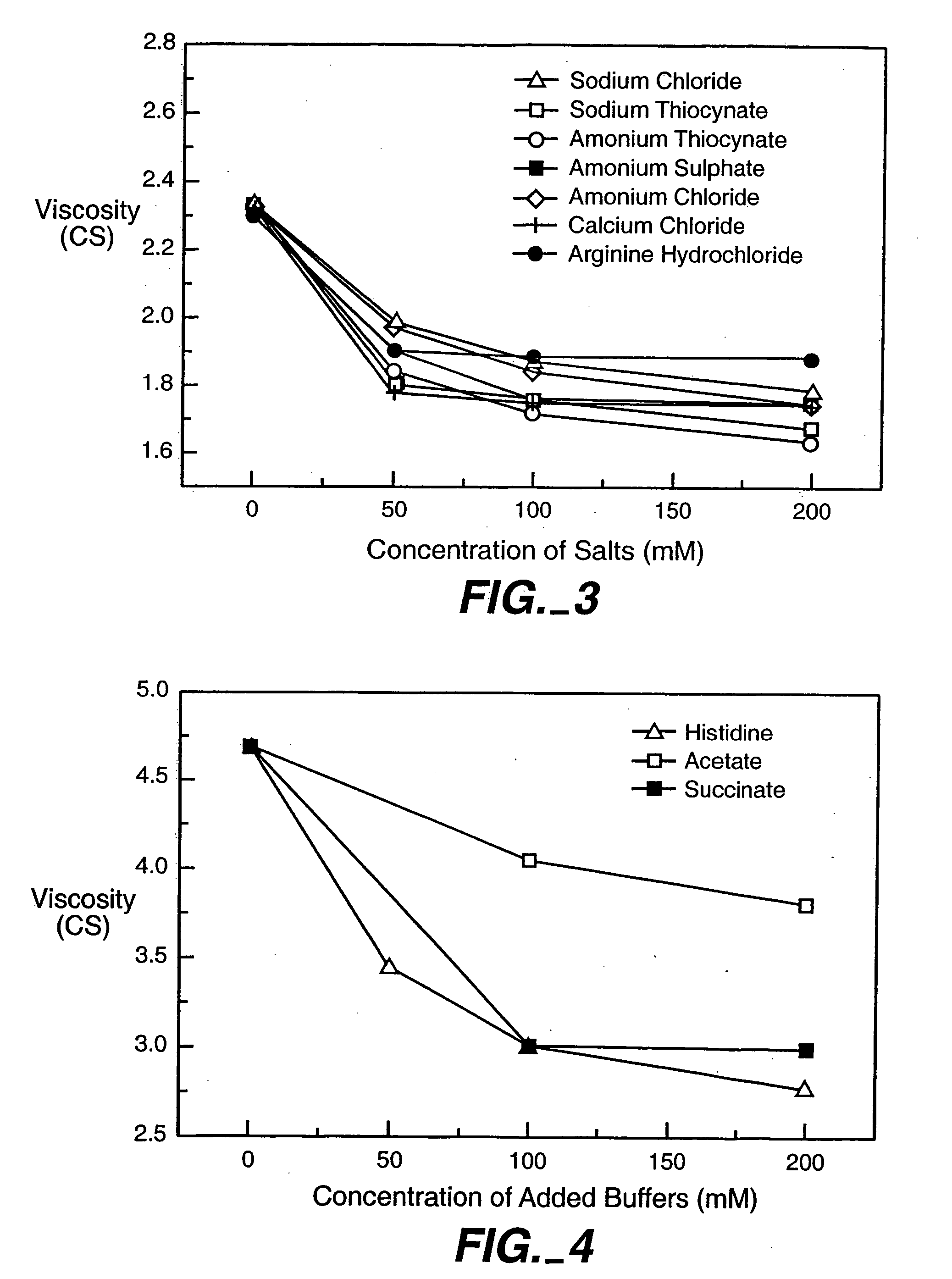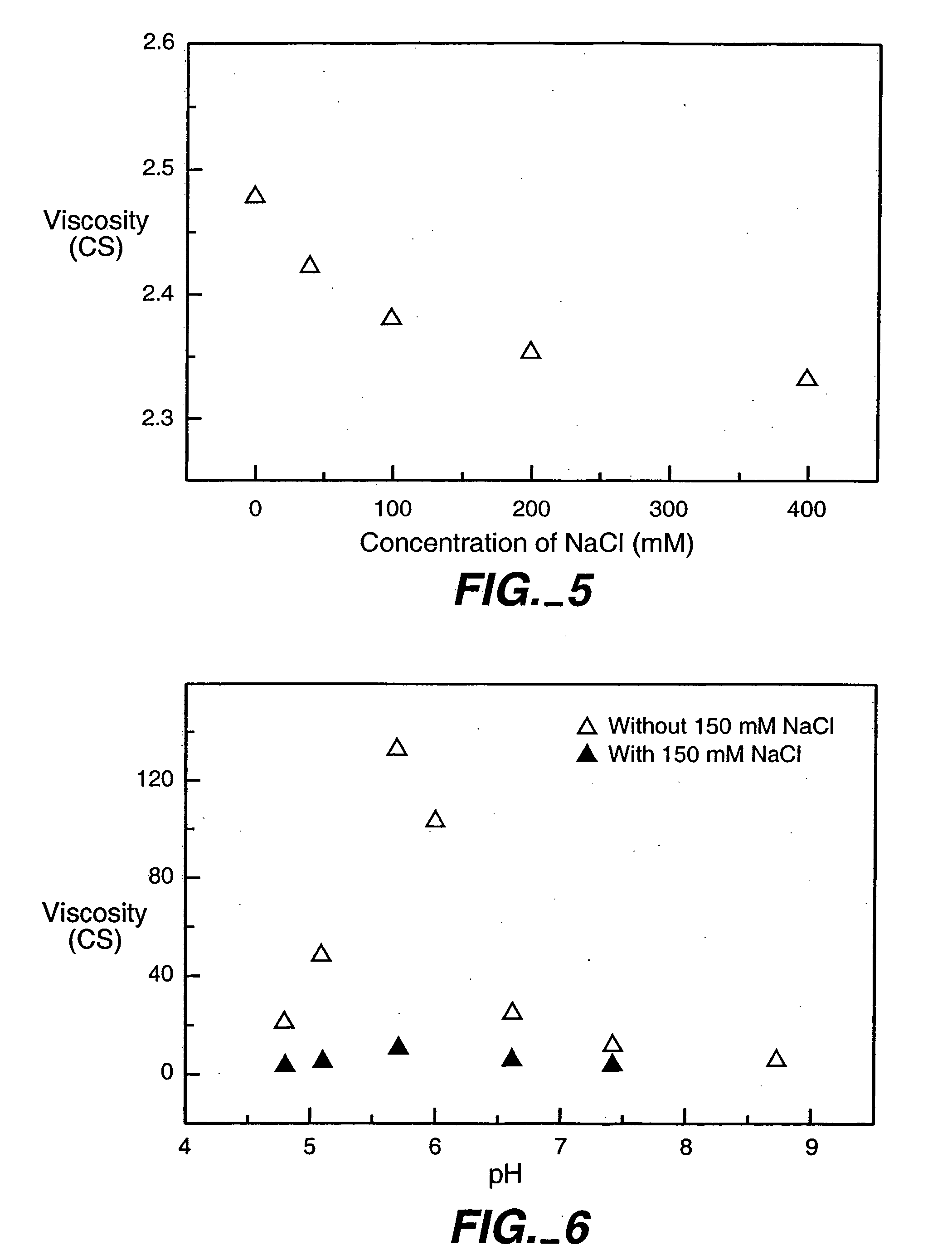Reduced-viscosity concentrated protein formulations
a concentrated protein and viscosity reduction technology, applied in the field of concentrated protein formulations, can solve the problems of high viscosity value of protein formulations, special problems of protein formulations, and high concentration of protein formulations, and achieve the effect of preventing self-association of proteins
- Summary
- Abstract
- Description
- Claims
- Application Information
AI Technical Summary
Benefits of technology
Problems solved by technology
Method used
Image
Examples
example 2
[0158] The lyophilized rhuMAb E25 of Example 1 was reconstituted with different concentrations of NaCl solution. The viscosity of reconstituted solution was measured at 25° C. in a Cannon-Fenske Routine capillary viscometer using the same method as described in Example 1.
[0159] The results as shown in FIG. 2 demonstrate that the addition of NaCl can significantly reduce the viscosity of the protein formulation. The reconstituted rhuMAb E25 with 100 mM NaCl will give the solution that is about 4 fold less viscous than that reconstituted with SWFI.
[0160] The preparation of a rhuMAb E25 lyophilized formulation with 100 mM NaCl resulted in a slightly hypertonic solution. However, as reported previously, strict isotonicity is not absolutely necessary in that tissue damage was detected only when at extremely high tonicity levels (1300 mOsmol / Kg).
[0161] Thus, the administration of a formulation containing higher concentration of salt (100 mM to 200 mM NaCl resulting in osmolarity of ˜60...
example 3
[0162] The effects of different salts on the viscosity of rhuMAb E25 solution were studied at 25° C. The lyophilized rhuMAb E25 was first reconstituted with SWFI to produce a solution with rhuMAb E25 at 125 mg / ml, 266 mM sucrose, 16 mM histidine, 0.03% Polysorbate 20. The samples were then diluted with 10 mM histidine, 250 mM sucrose, pH 6.0 to a final concentration of 40 mg / ml. Various concentrated salts were then added into solution to bring the final salt concentration ranging from 0-200 mM. The viscosity of solution was determined in a Cannon-Fenske Routine capillary viscometer using the same method as described in Example 1.
[0163] The results were demonstrated in FIG. 3. Although each salt shows slightly different impact on change of viscosity, they appear to follow a similar trend whereby the viscosity of the solution decreases with increase in buffer concentration and ionic strength.
example 4
[0164] Also studied were the effects of different buffers on viscosity of rhuMAbE25 solution at 25° C. A liquid formulation containing 80 mg / ml of rhuMAb E25, 50 mM histidine, 150 mM trehalose and 0.05% of Polysorbate 20 was added with different amounts of histidine, acetate, or succinate buffer components. The pH of sample was maintained at ˜6.0 for all the preparation. The viscosity of solution was determined in a Cannon-Fenske Routine capillary viscometer using the same method as described in Example 1.
[0165] As shown in FIG. 4, the viscosity of solution containing either histidine or acetate buffers decreases with increasing buffer concentration up to 200 mM. However, for succinate buffer, the viscosity of solution decreases only at low buffer concentration (200 mM). Similar results have also been observed in other buffers that contain negatively charged multivalent buffer components, such as phosphate, citrate and carbonate.
PUM
| Property | Measurement | Unit |
|---|---|---|
| weight | aaaaa | aaaaa |
| weight | aaaaa | aaaaa |
| volume | aaaaa | aaaaa |
Abstract
Description
Claims
Application Information
 Login to View More
Login to View More - R&D
- Intellectual Property
- Life Sciences
- Materials
- Tech Scout
- Unparalleled Data Quality
- Higher Quality Content
- 60% Fewer Hallucinations
Browse by: Latest US Patents, China's latest patents, Technical Efficacy Thesaurus, Application Domain, Technology Topic, Popular Technical Reports.
© 2025 PatSnap. All rights reserved.Legal|Privacy policy|Modern Slavery Act Transparency Statement|Sitemap|About US| Contact US: help@patsnap.com



